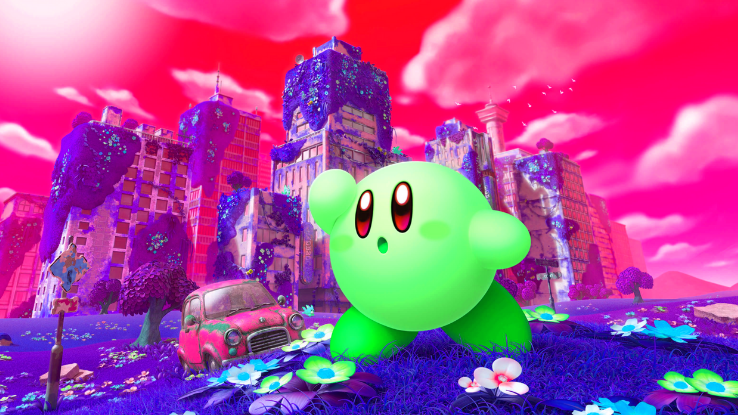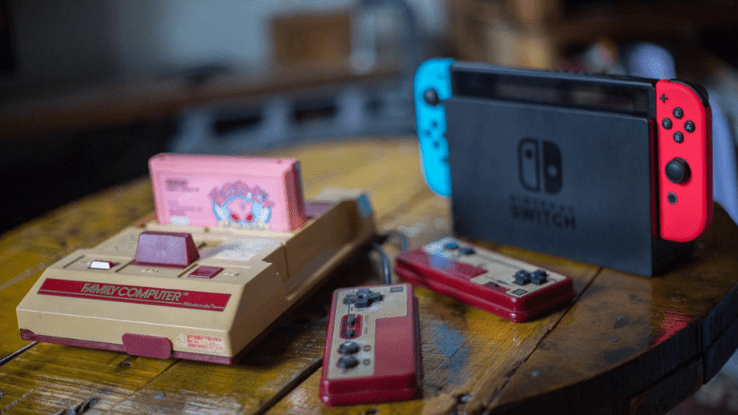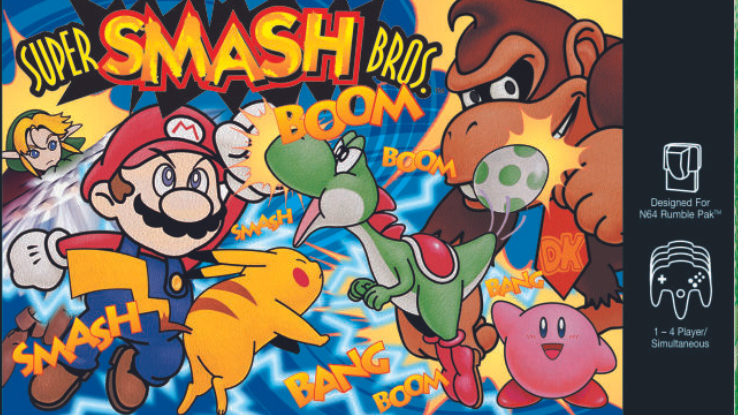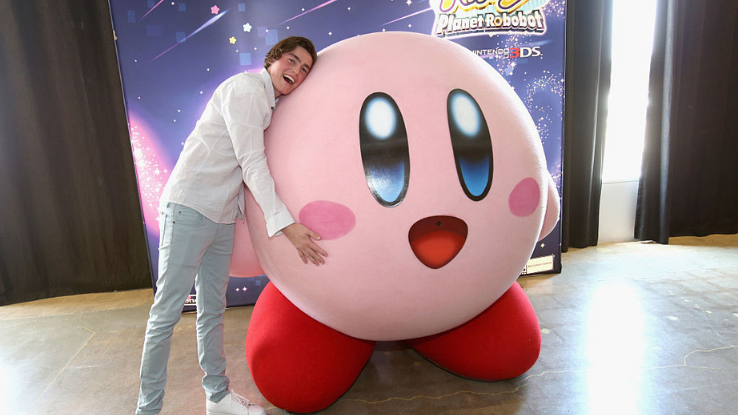
Kirby, everyone’s favorite flying blob, is turning 30. Falling just short of the success of the titular star of Super Mario Bros. and Legend of Zelda’s Link, Nintendo’s other, other flagship hero has joined the “geriatric millennial” crowd. Given his tendency to inhale everything from food to foes, we imagine Kirby is a big fan of brunch and iced coffee — but has no idea how to use TikTok, opting to transform into rock-Kirby and smash the phone instead.
Feeling a little lost? Kirby hasn’t quite saturated pop culture to the level Mario or Pikachu have, but it’s certainly worth your while to learn more about Nintendo’s pink puffball. With more than 12 mainline games in the Kirby series and over 20 spinoff titles, there are literally more Kirby games than years that the character has existed. With over 40 million copies of Kirby-starring games sold worldwide, he’s a major force to be reckoned with in the gaming world. And while Nintendo isn’t holding a massive celebration for Kirby, they’re finally allowing the character to “grow up”.
Kirby’s latest adventure, Kirby and the Forgotten Land, arrives on the Nintendo Switch in March 2022. The game features open-world stages that allow Kirby to finally break from the traditional side-scrolling platformers he’s known for. It’s been a long, cloudy road for the marshmallow-like hero. To honor the series and its iconic hero, we’re looking at Kirby’s beginnings, and what heights he’ll float to next.
Kirby’s Game Boy Beginnings

Kirby’s Dreamland was born from a directive to make a game like Super Mario Bros. but for beginners, which might partly explain Kirby’s cute design. Created by Masahiro Sakurai, Kirby was originally referred to as “Popopo”, and, back in 1992, he didn’t have his signature “copy” ability — the skill that allows him to mimic an enemy’s special moves. Instead, the mechanics of Kirby’s Dreamland were pretty minimalistic; all players can do in the game is walk, fly and vacuum up small objects and enemies. (Yes, Kirby opens his mouth and literally inhales foes.) This straightforward gameplay made space for Sakurai to go all out in designing a world that was both original and attractive. By 1993, Kirby became pink and gained his copy ability for Kirby’s Adventure.
Over the decades, Kirby’s world has been built out more. Most of Kirby’s adventures take place on Planet Pop Star, but he is known to explore space, too. Kirby has animal helpers, like Rick the hamster, Kine the sunfish and Coo the owl, among others. And many of Kirby’s enemies return in multiple installments, either needing to be saved by the superstar or teaming up with him, not unlike Batman villains.
The “Star” of Super Smash Bros. and a Mascot for Innovation

As the technology improved, Kirby became a bit of a guinea pig for Nintendo. This meant that there were Kirby titles in different genres outside of platforming. Kirby has been featured in puzzle games (Kirby’s Avalanche), racing games (Kirby’s Air Ride) and even arcade games (Kirby’s Pinball).
Kirby was also given the honor (or duty?) of testing out the latest hardware Nintendo has had on offer over the years. Like in Kirby’s Tile and Tumble, which said “goodbye” to the control stick/D-pad and restricted Kirby’s movement to the tilting of your Game Boy. In a similar fashion, Kirby’s Epic Yarn utilized the Nintendo Wii’s motion-sensing technology and Kirby’s Canvas Curse showcased the touchscreen and stylus featured on the Nintendo DS.
While all this was going down, Kirby became the “series lead” in the Super Smash Bros. franchise, which debuted in 1999 on the Nintendo 64 and sees Nintendo’s beloved characters duking it out in an all-out brawl. So, what led to Kirby becoming maybe the star of this star-packed franchise — of one of the greatest crossover events in history? Sakurai was tasked with leading the development of these games. Kirby’s moveset makes him one of the least competitive characters in the game, but he’s the least difficult to master. But the story mode in 2018’s Super Smash Bros: Ultimate, however, sets up that Kirby is the only character in the game who can save the day. (At least at first.)
Why Kirby and the Forgotten Land Is Huge for the Franchise

Kirby and the Forgotten Land has been a longtime coming. Nintendo has promised Kirby fans a 3D platforming adventure as far back as the GameCube days. That’s a promise that’s two decades old! Nintendo focused on transitioning other characters to 3D in the mid-1990s starting with Mario in Super Mario 64. Franchises like Donkey Kong, The Legend of Zelda, Metroid and others have all had those 3D treatments. Even Pokemon has 3D adventures out there. Nintendo, for some odd reason, has left the training wheels on Kirby’s franchise. After years of patience, Kirby’s fans are now getting a more immersive experience — one that caters to older fans and those who want a little more complexity in their games.
Kirby and the Forgotten Land is utilizing open-world staging. It’s all the rage right now in the world of gaming Just look at hits like Breath of the Wild and Monster Hunters: Rise, for example. The thing about Kirby games is that they’re always on the easy side. This open-world style of gaming offers more opportunities to ramp up the difficulty, hide collectibles, and interact with enemies in completely different ways.
While Kirby’s Planet Pop Star is filled with love and candy, something about Forgotten Land’s setting feels eerie and just right for today’s climate. Instead of cute surroundings, Kirby is on a planet that looks like our Earth for once. While far from a gritty reboot, a little bit of realism changes the tone from that of a traditional Kirby game. Could Nintendo be making a statement about climate change by making Kirby save a disregarded Earth-like planet? You’ll have to play to find out.
What’s Next for Gaming’s Original Sweetheart?

By no means does a realistic Kirby game mean that the beloved hero will be done with his traditional games. If anything, many of Kirby’s games will be rereleased over the next few years so new audiences can enjoy them. As far as whether or not we’ll get more open-world Kirby games, that likely depends on the critical reception of Forgotten Land.
At this point, one of the few genres that Kirby has yet to set foot in are RPGs. Wouldn’t it be fabulous for Kirby to get the Super Mario RPG or even Paper Mario treatment? Kirby games have such great world-building already, so things like party members, enemies and different settings are all ready to go. Already a star of manga and film, maybe Nintendo will introduce virtual reality technology and send Kirby to the metaverse. Who knows?!
The only guarantee for Kirby’s future can be found in one word: merchandise. Whether it’s Nintendo-approved or made solely from the passion of a fan, Kirby is everywhere. T-shirts, plushies, keychains—nearly everything could be Kirby-fied. In Japan, there are even Kirby-themed cafes. Maybe we’ll see Dreamland or Planet Pop Star somewhere in one of Universal’s new Nintendo themed amusement parks.
No one could have guessed how lovable Kirby was 30 years ago nor could they have known he’d be so huge today. We’d say the sky’s the limit for Kirby, but he already rides on stars like cars. There really is no limit to what Nintendo could do with Kirby and that’s why so many people find joy in the character as well as the games.






